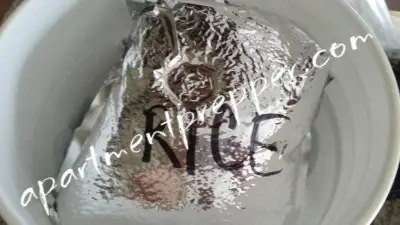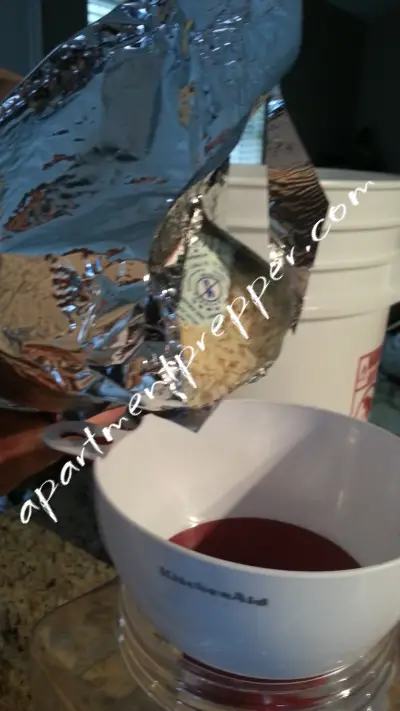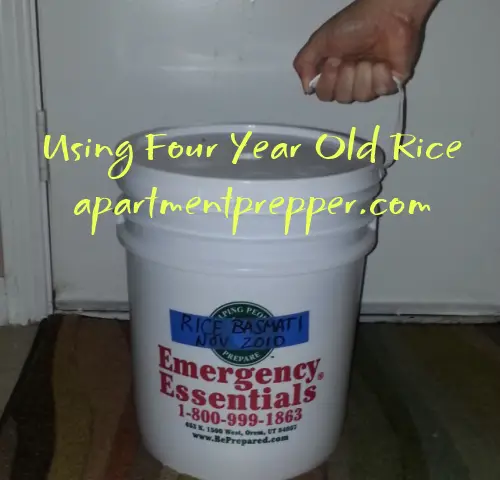This post is by Bernie Carr, apartmentprepper.com
We are rotating the first batch of rice we stored away and replacing it with the new batch. I bought the rice back in April 2010 but did not repackage it for for long term storage until November 2010. Usually, rice that is left in a pantry with no special packaging will last one to two years.
Since this is the first time I am using my rice storage I was really curious as to how the mylar bag/oxygen absorber packed rice held up. We don’t keep it especially cold in our apartment – usually 75-78 degrees, and it does get humid indoors sometimes.
First, Mr. Apt Prepper opened up the five gallon bucket. I didn’t realize they are not the easiest things to open, which is actually a good thing, because you know the contents are safe. After he released the plastic zip seal, he had to slowly pry open the lid with a butter knife. It would have been easier to have a bucket opener so I added one to the Amazon wish list.
 Once opened, we examined the mylar bags inside and found them to be the same as when we packed them nearly four years ago. The bags were still very much air tight as they shrink around the food once the oxygen absorber activates. When I opened a bag, I found that the oxygen absorber was still soft and fresh, and did not harden as expired ones do. I poured the contents into a jar, and cooked up a batch.
Once opened, we examined the mylar bags inside and found them to be the same as when we packed them nearly four years ago. The bags were still very much air tight as they shrink around the food once the oxygen absorber activates. When I opened a bag, I found that the oxygen absorber was still soft and fresh, and did not harden as expired ones do. I poured the contents into a jar, and cooked up a batch.
 The rice tasted good and there was no difference in taste or texture at all. I am really glad the process works, and feel confident the food storage will hold up for many years.
The rice tasted good and there was no difference in taste or texture at all. I am really glad the process works, and feel confident the food storage will hold up for many years.
Buying food in bulk and repackaging it yourself is a cost effective way to store for emergency long term storage. As long as you keep rotating your food, it will not go to waste. If you’d like to get started repackaging bulk food for long term storage, the easiest method is described here.
© Apartment Prepper 2014


The year was 1999. Lost my Job. Cashing in my Investments. I was using my money wisely.
Bought Bulk rice At 6(Six) pounds for a dollar. Pinto beans were 5(Five) pounds for a dollar. Well I bought some. Stored it, Rice/Beans, in 3(three liter) pop bottles that had been cleaned out and dried out.
Well I had lost track of a few in the store room and found them in 2012.
When I opened them I heard the distinctive Whoosh (Airtight container being opened). The beans smelled O.K. and the rice smelled like rice. When I cooked them up they both tasted fine.
That is Twelve years stored in plastic airtight containers. 12 YEARS.
Thanks for your Post. ed
Hi ed, Great to know 12 year old rice and beans turned out fine. Thanks for sharing this with us!
I have rice in a bucket, no O2 absorber, no mylar bag and using a gamma seal top. It is probably 7 years old and tastes great. I use it irregularly. Don’t know about the nutritional value though. Thanks for the article!
Hi Don, That’s great your rice turned out fine too – 7 years with just the gamma seal top! Thanks for the comment.
I have (16) 5 gallon buckets of rice.
I have no plans to get rid of it–it is long term…which is what rice is meant to be.
No absorbers, no mylar–just rice in the bucket with DE for insects.
Please, people. Stop making this so hard—it’s rice. Not gold.
When stored properly, these everyday items will last for years — sometimes decades — even after they’ve been opened
1. HONEY
Pure honey is as durable as it is delicious; it keeps safe indefinitely. Honey may change color or crystallize over time, but that won’t make it unsafe.
Keep it fresh: Store in a cool area and keep tightly closed. Revive crystallized honey by placing the opened jar in warm water and stirring until dissolved.
2. RICE
White, wild, arborio, jasmine and basmati rice all have an indefinite shelf life, when kept free from contaminants. The exception: brown rice. Thanks to its higher oil content, it won’t keep nearly as long.
Keep it fresh: Store in a cool, dry area. Once opened, place rice in a sealed airtight container or place original package in a resealable heavy-duty freezer bag. For added protection, store rice in the refrigerator or freezer.
3. SUGAR
White, brown or powdered — sugar never spoils because it doesn’t support bacterial growth. The real challenge is to prevent it from becoming rock-hard.
Keep it fresh: Keep sugar in a cool, dry area. To prevent sugar from hardening after opening, place it in an airtight container or cover the original package in a heavy-duty plastic bag and seal tightly.
4. HARD LIQUOR
Whipping up some penne alla vodka and a pitcher of cocktails? Distilled spirits —vodka, rum, whiskey, gin, tequila and the like — don’t spoil, even after opening. The taste and aroma may fade gradually, but it’ll take ages before you notice.
Keep it fresh: Store in cool, dark area, away from direct heat or sunlight. Keep bottle tightly closed when not in use.
5. MAPLE SYRUP
Pure maple syrup not only makes your pancakes special, it adds tremendous flavor to a whole range of dishes. Best of all, it keeps forever in the freezer.
Keep it fresh: Refrigerate after opening. For long-term storage, freeze maple syrup in airtight plastic containers.
6. PURE VANILLA EXTRACT
Yes, it’s more expensive than its imitation counterpart. But pure vanilla extract keeps forever, so you’ll never have to waste a drop.
Keep it fresh: Store in cool, dark cupboard and keep tightly closed when not in use.
7. DISTILLED WHITE VINEGAR
A reliable standby in everything from marinades to salad dressings, distilled white vinegar will remain virtually unchanged as the years pass by.
Keep it fresh: Store vinegar a cool, dark area and keep tightly capped after each use.
8. CORNSTARCH
A must-have for thickening sauces, gravies, and puddings. Cornstarch will keep indefinitely if it’s kept dry and free from contaminants.
Keep it fresh: Store in cool, dry area; keep package tightly closed between uses.
9. SALT
From the basic table variety to fancier versions like kosher and sea, salt is a flavor enhancer that never spoils or goes stale.
Keep it fresh: Store in cool, dry area.
That is fine if you live in a dry cool environment. Since we live in a hot, humid area, I prefer to go the extra mile and pack my long term storage items in mylar bags with oxygen absorbers. It’s more of a small insurance against food going bad when we do need it.
Buckets get more expensive every year–what a waste of space using mylar bags for something like rice.
Not very smart.
Jayjay- It may not make sense to you but it sure does for us. Keeping the rice in mylar bags with oxygen absorbers keeps the air out, which is is an enemy of food storage.
Air can no way get in my buckets with lids I have to hammer on.\
No way.
Remember that moisture is the enemy. Oxygen absorbers take out the oxygen but not any moisture. The stock needs to be dry and sealed air tight to keep moisture out. Moisture in a low oxygen environment leads to botulism.
This is true-everything must be completely dry and air tight as you pack food for long term storage.
I just got one of those bucket openers in the paint department at Lowes for less than $2.00.
Great tip Joan, thanks!
Joan, I just bought another bucket opener.
thanks for reminding me.
2 is 1, and 1 is 0.